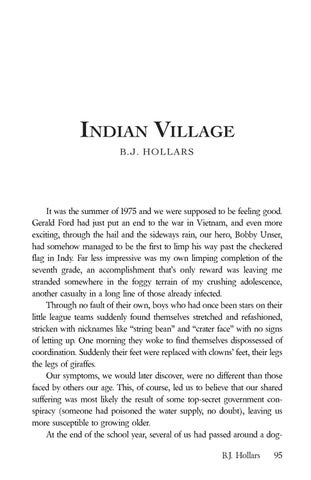indian village B.J. HOLLARS
It was the summer of 1975 and we were supposed to be feeling good. Gerald Ford had just put an end to the war in Vietnam, and even more exciting, through the hail and the sideways rain, our hero, Bobby Unser, had somehow managed to be the first to limp his way past the checkered flag in Indy. Far less impressive was my own limping completion of the seventh grade, an accomplishment that’s only reward was leaving me stranded somewhere in the foggy terrain of my crushing adolescence, another casualty in a long line of those already infected. Through no fault of their own, boys who had once been stars on their little league teams suddenly found themselves stretched and refashioned, stricken with nicknames like “string bean” and “crater face” with no signs of letting up. One morning they woke to find themselves dispossessed of coordination. Suddenly their feet were replaced with clowns’ feet, their legs the legs of giraffes. Our symptoms, we would later discover, were no different than those faced by others our age. This, of course, led us to believe that our shared suffering was most likely the result of some top-secret government conspiracy (someone had poisoned the water supply, no doubt), leaving us more susceptible to growing older. At the end of the school year, several of us had passed around a dogB.J. Hollars
95

